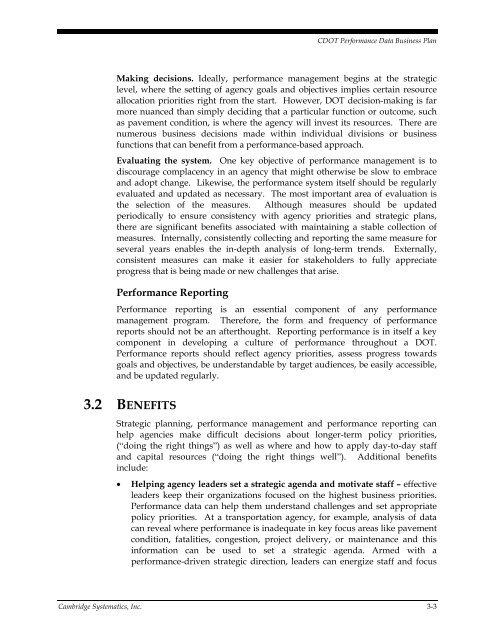CDOT Performance Data Business Plan - Cambridge Systematics
CDOT Performance Data Business Plan - Cambridge Systematics
CDOT Performance Data Business Plan - Cambridge Systematics
Create successful ePaper yourself
Turn your PDF publications into a flip-book with our unique Google optimized e-Paper software.
<strong>CDOT</strong> <strong>Performance</strong> <strong>Data</strong> <strong>Business</strong> <strong>Plan</strong><br />
Making decisions. Ideally, performance management begins at the strategic<br />
level, where the setting of agency goals and objectives implies certain resource<br />
allocation priorities right from the start. However, DOT decision-making is far<br />
more nuanced than simply deciding that a particular function or outcome, such<br />
as pavement condition, is where the agency will invest its resources. There are<br />
numerous business decisions made within individual divisions or business<br />
functions that can benefit from a performance-based approach.<br />
Evaluating the system. One key objective of performance management is to<br />
discourage complacency in an agency that might otherwise be slow to embrace<br />
and adopt change. Likewise, the performance system itself should be regularly<br />
evaluated and updated as necessary. The most important area of evaluation is<br />
the selection of the measures. Although measures should be updated<br />
periodically to ensure consistency with agency priorities and strategic plans,<br />
there are significant benefits associated with maintaining a stable collection of<br />
measures. Internally, consistently collecting and reporting the same measure for<br />
several years enables the in-depth analysis of long-term trends. Externally,<br />
consistent measures can make it easier for stakeholders to fully appreciate<br />
progress that is being made or new challenges that arise.<br />
<strong>Performance</strong> Reporting<br />
<strong>Performance</strong> reporting is an essential component of any performance<br />
management program. Therefore, the form and frequency of performance<br />
reports should not be an afterthought. Reporting performance is in itself a key<br />
component in developing a culture of performance throughout a DOT.<br />
<strong>Performance</strong> reports should reflect agency priorities, assess progress towards<br />
goals and objectives, be understandable by target audiences, be easily accessible,<br />
and be updated regularly.<br />
3.2 BENEFITS<br />
Strategic planning, performance management and performance reporting can<br />
help agencies make difficult decisions about longer-term policy priorities,<br />
(“doing the right things”) as well as where and how to apply day-to-day staff<br />
and capital resources (“doing the right things well”). Additional benefits<br />
include:<br />
<br />
Helping agency leaders set a strategic agenda and motivate staff – effective<br />
leaders keep their organizations focused on the highest business priorities.<br />
<strong>Performance</strong> data can help them understand challenges and set appropriate<br />
policy priorities. At a transportation agency, for example, analysis of data<br />
can reveal where performance is inadequate in key focus areas like pavement<br />
condition, fatalities, congestion, project delivery, or maintenance and this<br />
information can be used to set a strategic agenda. Armed with a<br />
performance-driven strategic direction, leaders can energize staff and focus<br />
<strong>Cambridge</strong> <strong>Systematics</strong>, Inc. 3-3

















